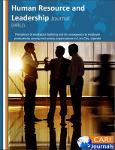| dc.contributor.author | Otema, Opio Denis | |
| dc.contributor.author | Acanga, Alfred | |
| dc.contributor.author | Mwesigwa, David | |
| dc.date.accessioned | 2023-02-06T12:37:19Z | |
| dc.date.available | 2023-02-06T12:37:19Z | |
| dc.date.issued | 2022 | |
| dc.identifier.citation | Otema, O. D., Acanga, A. A., & Mwesigwa, D. M. (2022). Prevalence of workplace bullying and its consequence to employee productivity among civil society organizations in Lira City, Uganda. Human Resource and Leadership Journal, 7(2), 67-94. | en_US |
| dc.identifier.uri | http://ir.lirauni.ac.ug/xmlui/handle/123456789/493 | |
| dc.description.abstract | Purpose: This study aimed to investigate the effects of the prevalence of workplace bullying on employee productivity of CSOs in Lira City by focussing on three aspects, viz. workplace bullying and employee attendance, workplace bullying and employee efficiency, and workplace bullying and teamwork.
Methodology: This study used descriptive case study and correlational designs. The study employed a mixed methods approach, involving the collection and analysis of both quantitative and qualitative data. Primary data from the field was collected by the researcher using research tools. Primary data were obtained first-hand from the target respondents defined by seeking their knowledge, experiences and/or opinions about the impact of workplace bullying on employees’ productivity. External validity which refers to the extent to which the findings of a particular can have credibility and generalizability across populations, contexts and time, the researcher triangulated using both quantitative and qualitative methods.
Findings: Results that workplace bullying is significantly prevalent among the institutions investigated (Mean = 3.614; std. = 1.02) and from the highest extreme, the study shows that superiors maliciously discount the achievements of the subordinates (mean = 3.766; std. = 1.042). The statistics suggest that a variation in workplace bullying is associated to a weak variation in workers’ absenteeism. The significant value shows that the correlation is significant and that workplace bullying and employee absenteeism are linearly related. Also, the results show that bullying contributes 11% (R Square = .101) of the variations in employee productivity however when treated in isolation, the effect of workplace bullying is not adequate to explain the level of absenteeism among the selected institutions. So a variation in bullying practices is associated to a variation in slowdown of work even if is not very significant. This can be attributed to the fact that slowdown does not mean complete withdrawal of labour like absenteeism, and therefore its ramifications on productivity is not severe.
Conclusion and recommendations: From the study, it was inferred workplace bullying negatively affect productivity in international non-governmental organizations due to the fact that bullied employees continuously complain of depression and mental illness which put them in the maze of absenting from work. Even when they keep coming for work, bullied employees complain of nervous breakdown and feign sickness just to escape the hostile work environment. Hence, the need to create awareness about what bullying is and how it can be prevented, as a starting point for creating conducive working environments, and organisational managers should not take workplace bullying lightly but should take it as something costly for organizations and therefore should be prevented or redressed by putting in place anti-bullying policies and measures.
Unique contribution to policy and or practice: This study provides additional evidence to the Lira context as well as helping to widen the methodology of measuring this relationship between workplace bullying and worker productivity. | en_US |
| dc.language.iso | en | en_US |
| dc.publisher | Human Resource and Leadership Journal | en_US |
| dc.subject | Workplace bullying | en_US |
| dc.subject | Employee productivity | en_US |
| dc.subject | NGOs | en_US |
| dc.subject | Absenteeism | en_US |
| dc.subject | Work rate | en_US |
| dc.title | Prevalence of workplace bullying and its consequence to employee productivity among civil society organizations in Lira City, Uganda | en_US |
| dc.type | Article | en_US |

